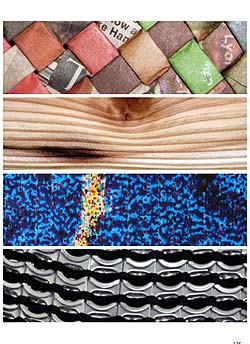Green Design
edited by Buzz Poole

“Oh no! Not Another Book on Environmental Design”?
review by David Fowler
|
Over the years I have tried to absorb and gain knowledge from a range of green ‘text’, be it books or articles, and have generally found them to fall into two categories:
1] Academic - e.g. Design for the Real World, by Victor Papenak (the bible of responsible design)
2] Press articles that aim to scare but are unable to provide viable and realistic solutions attainable by the reader.
So I rarely expect to see a title that is both approachable and useful to appear in the environmental design field. My reaction on seeing another book aimed at this market is usually “Oh no! Not another book on environmental design?”. And here is another book aimed at this market - will be preconceptions be confirmed?
|
|
Green Design: The Blurb
YOU ARE AN OLD TREE in a California orchard out in the Central Valley. Many summers worth of the sun beating down and the oven-hot winds that lash you about have stanched your ability to fruit. The farmer who owns the land where you grow needs the ground you inhabit to plant another tree that will produce more than your old branches can yeild. The farmer knows not to burn you, and saves you for the group of industrious city folk who reclaim wood and give it a new life. They collect you from the farm and take you to a processing plant in the outer reaches of the Bay Area, where you are recycled and made into an envelope. You are bought in a store in Berkeley and stuffed with a letter destined for New York City. From the West Oakland postal hub, you are loaded into a trailer that is flown across the couintry. In the Bronx, the recipient of the letter eagerly tears you open. A few days later, as the apartment is tidied up, you are placed into a bag with other recyclable papers, and a few days after that you are put out on the curb where you are collected and taken to anther processing plant and made anew, this time into a colorful newsprint coupon insert. As a designer leafs through the paper one Sunday morning, she is enamoured by the garishly busy logo of the orange juice you advertise so she puts you aside for a project, one that transforms you into a bag made of newsprint. The bag is sold at a boutique in Manhatten's Lower East Side and you are proudly sported on the shoulder of an appreciative, but absent-minded, woman. One blustery, chilly morning, she does not tighten the top of her thermos full of coffee enough and as she skips out of a cab's way the thermos is jostled in the bag: the lid comes off and the coffee spills. In the lunch room at work, the woman laments the mishap as she empties the bag's soggy and coffee-stained contents; the bag is equally soggy and coffee-stained. The woman states that she cannot bear to throw out the bag, but she is reminded by a coworker that she can recycle it. Once again, you are sent to a processing plant, atop a pile of old newspapers. This time you are made into a 150gsm Magno recycled glossy book jacket and you are the story being held, the one just told.
|
|
My initial impression of the book was unfavourable, because I found the cover to be similar to others covering the subject. I know this was wrong, but in this instance I did judge the book by its cover - “hasn’t this subject been covered so many times before?”, I thought.
Besides this, the conceptual framework set up by the blurb inside the fly-leaf worked extremely well, wetting the appetite for the main text (see sidebar). So, on further inspection I found this to be a very accessible book, the content contextualising the subject well, providing a broad range of case studies. It has mass appeal and would be accepted by students, professionals and the general public.
In the past I have found books on the subject to be rather dry and pious. This book gets the balance right and makes key points that aren’t usually made in other environmental design books.

I particularly liked the Lego Toy section (could this be brand loyalty for the young consumer?). This illustrates a fundamental point that we end to overlook - generally green design focuses on recycling as the main area to help ease the problems associated with the cause, so I liked the tone of the book, which favoured the notion of making green design aesthetically desirable from both the designer and consumer point of view. This seems different from the norm, and a new ‘take’ on promoting environmentalism as an issue.
The thesis of the book seems to recognise our wants / desires / needs as a consumer society, and at the some time implicitly posits that change can be made by the average Joe with, perhaps, no necessity for radicalism.
Green Design is an enjoyable read, a good entry level book. The balance between images and text makes for an easy read without too much rhetoric or jargon. The case studies help the reader to understand fundamental issues and provide possible solution that could be undertaken and achieved by others (see for example, the woollen toy). It gets over the message that we can make change and enjoy it too.

The images (see the fashion pictures for example) feel cool, contemporary, and made we want to contribute in an artistic way - I have not seen this approach pushed so much before.
The book recognises the negative stereotyping of the subject and uses this awareness to more positively support the underlying issues / worthy causes without appearing too glib.

My only concerns were the title and front cover design of the book:
‘Green Design’ - the title could have been so much more exciting. How many books have been titled like this? It fails to inform what the book is about - if I saw this in a bookshop I would bypass it! It could be more revealing. Subjectively, the cover has too mechanical / computer oriented an aesthetic, making the subject appear too technical, which is a shame…
Because, once you start reading it you realise it has much to offer in terms of considering ways to help environmental concerns. This is certainly a book I would recommend, but I would make the cover more inspirational / aspirational in its design idea and layout.

To make the title reveal more of the books intent I would have chosen something like "What is Green Design?” or “What Green Design Can Be”.
– Reviewer: David Fowler is Course Team Leader on the Foundation Degree in Graphic Communications, University of Brighton.
|
About Green Design
So you've noticed that this page doesn't look or feel like most of the other paper in this book. Why?
We knew that publishing a book called Green Design on virgin paper would undermine our credibility, so we printed this book on different kinds of recylced papers. This brown paper is SEK Speckle-tone Kraft recycled (non-deinked post consumer waste); the other pages in the book are Magno recycled matt; the casewrap is magno recylced glossy, as is the dust jacket.
|
|





